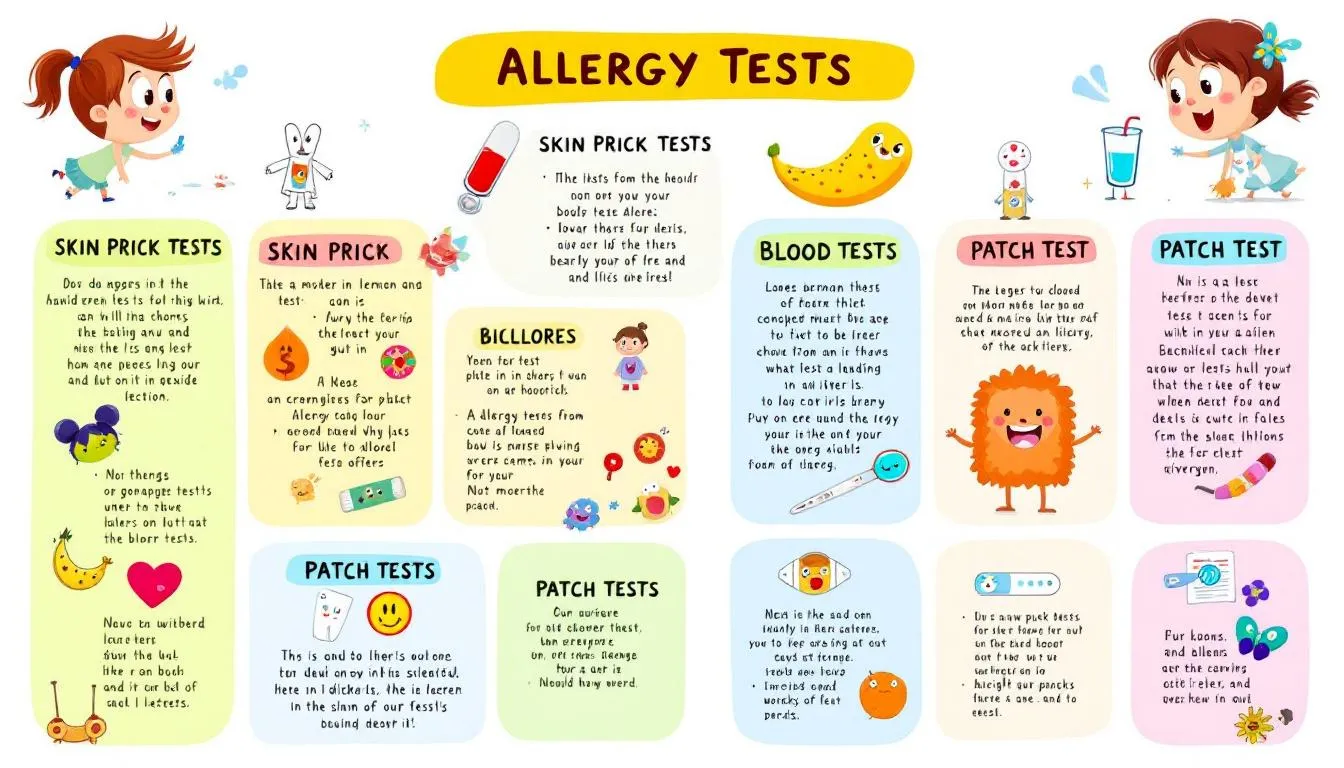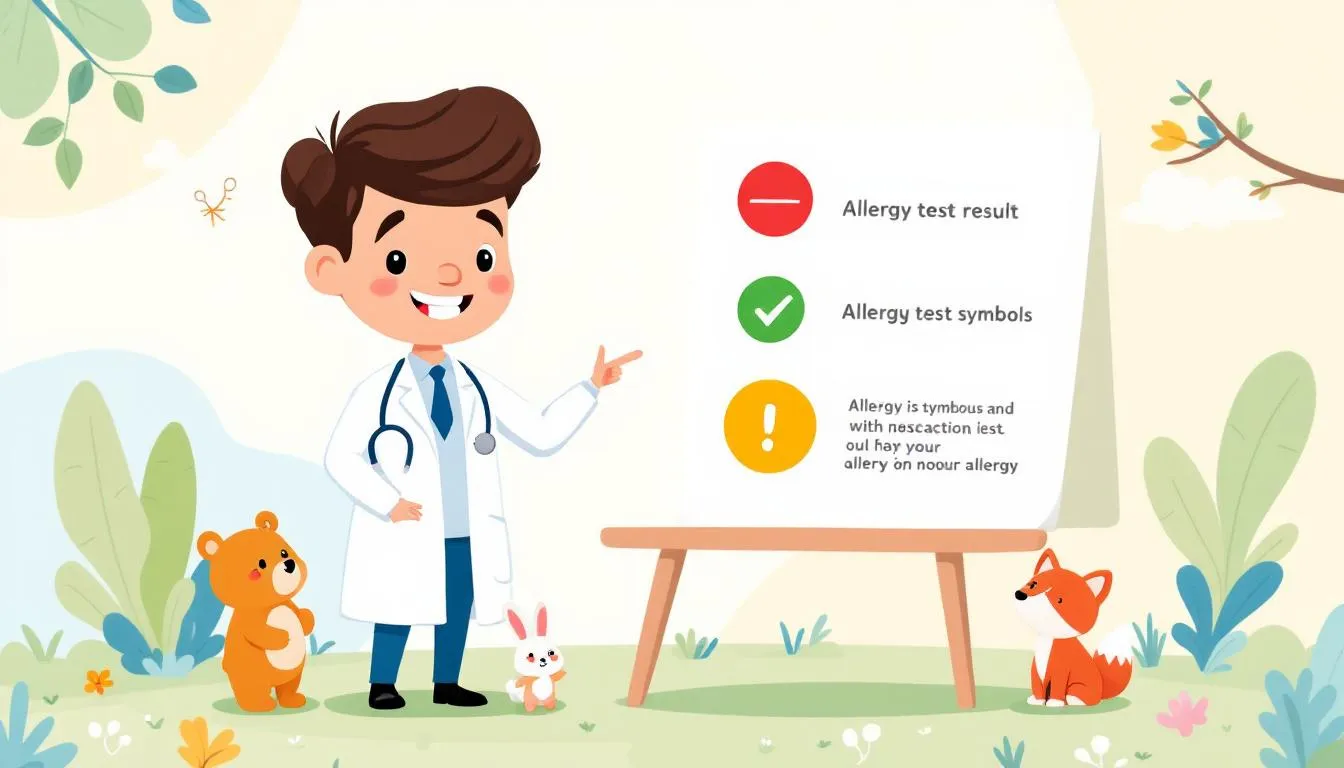Wondering if your symptoms could be due to allergies? A test for allergies can uncover the triggers causing your discomfort. This guide dives into different testing methods, such as skin prick and blood tests, explaining how they work and what results mean for you.
Key Takeaways
- Allergy tests identify specific allergens triggering allergic reactions, enabling targeted treatment plans for conditions like allergic rhinitis and asthma.
- Different types of allergy tests, including skin prick tests and blood tests, offer varying sensitivities and applications, necessitating careful selection based on individual needs.
- Interpreting allergy test results requires consideration of IgE antibody levels, with awareness of potential false positives and false negatives crucial for accurate diagnosis and management.
Understanding Allergy Tests

Allergy tests are designed to identify the substances, known as allergens, that trigger allergic reactions. These tests are vital tools for diagnosing various allergic conditions, including allergic rhinitis, asthma, and food allergies. Identifying the specific allergens causing your symptoms allows healthcare providers to create targeted treatment plans for effective symptom management.
Reviewing your medical history is crucial in the allergy testing process. This helps identify potential triggers based on past reactions and family history, guiding healthcare providers in selecting the right tests and interpreting results accurately.
What Allergy Tests Measure
Allergy tests evaluate how your immune system reacts to specific substances called allergens. These tests measure the body’s response to these allergens by assessing the levels of immunoglobulin E (IgE) antibodies produced during an allergic reaction. IgE antibodies are crucial in the immune response, as they bind to allergens and trigger symptoms such as sneezing, itching, and swelling.
Measuring IgE antibody levels specific to certain allergens helps diagnose allergies and assess reaction severity. This information is vital for creating a comprehensive, personalized allergy treatment plan.
Common Allergens Tested
Allergy tests commonly target a range of environmental and food allergens known to provoke allergic reactions, including a particular allergen. Environmental allergens often include:
- Pollen from trees, grasses, and weeds
- Dust mites
- Pet dander These allergens are ubiquitous and can cause symptoms such as hay fever, allergic rhinitis, and asthma symptoms, according to how allergies affect the allergy foundation.
Food allergens are another critical category tested during allergy assessments. Common food allergens include:
- Peanuts
- Tree nuts
- Milk
- Eggs
- Shellfish
Identifying these allergens is essential for individuals with food allergies, as it helps them avoid potentially life-threatening allergic reactions.
Types of Allergy Tests

Several types of allergy tests are used to diagnose allergies, each with its unique methodology and application. The main type of allergy tests include:
- Skin prick tests
- Blood tests for allergen-specific IgE
- Intradermal testing
- Patch testing
Additionally, an oral food challenge may be used to identify food or drug allergies in a food challenge.
Each type of test has its strengths and weaknesses. Knowing the strengths and weaknesses of each test aids in selecting the most suitable one for your situation, with your healthcare provider. Detailed explanations of these tests will follow in the subsequent sections.
Skin Prick Test
Skin prick testing is a widely used method for diagnosing allergies due to its convenience and quick results. In this allergy skin test, small amounts of allergen extracts are applied to pricked skin, with reactions observed within 15-20 minutes. It’s particularly effective for identifying allergies to common environmental allergens like pollen, ragweed, dust, and pet dander.
However, certain medications, such as antihistamines and some antidepressants, can interfere with the results of skin prick tests. Informing your healthcare provider about any medications you are taking is crucial for accurate test results.
Intradermal Skin Test
Intradermal skin testing involves injecting a small amount of allergen solution just under the skin. Key points about this method include:
- It is more sensitive than skin prick testing but generally less reliable.
- It is commonly utilized for testing allergies.
- It applies specifically to antibiotic drugs and insect venom, as well as insect stings. An intradermal test is often performed in conjunction with other testing methods.
While intradermal tests can indicate higher sensitivity to allergens, they may not always correspond to a reliable allergy diagnosis. Interpreting these results alongside your overall medical history and symptoms is essential.
Patch Testing
Patch testing is used to identify causes of contact dermatitis. Test substances are applied to the skin and left for 48 hours, after which the skin is examined for reactions to a particular substance. This method helps diagnose allergic reactions to substances like metals, fragrances, and preservatives commonly found in personal care products, including patch tests.
Blood Tests
Blood tests for allergies involve taking a blood sample from a vein in your arm. These tests measure the levels of IgE antibodies in the blood, providing information about specific allergens causing reactions. There are two main types of blood test: allergen-specific IgE tests and total IgE tests, including the allergy blood test.
Allergen-specific IgE tests identify the particular allergens triggering your symptoms, while the total ige test measures the overall level of IgE antibodies in your blood. It’s possible to have a normal total IgE level while still being allergic to specific substances. The specific ige test measures can help clarify these allergies.
Preparing for an Allergy Test

Proper preparation is key for accurate allergy test results. Patients should avoid using creams or moisturizers before testing, ensuring that allergen extracts can penetrate the skin effectively.
Depending on the specific tests, patients may need to fast for a few hours beforehand to ensure that recent food intake does not affect the body’s responses.
Medication Interference
Certain medications can interfere with allergy test results. Patients should inform their healthcare provider about all medications and supplements they are taking. Particularly, antihistamines should be stopped three to seven days before testing for accurate results.
Medical History Review
Reviewing your medical history is critical for accurate allergy diagnosis. Knowledge of past allergic reactions, family history, and existing conditions helps tailor the tests to your specific needs.
Risks and Side Effects of Allergy Testing

Allergy tests are generally safe but come with some risks and side effects. Common side effects include mild swelling, redness, and itching at the test site, typically resolving on their own within a few days. These side effects may sometimes be confused with allergy symptoms.
In rare cases, individuals with a history of severe allergic reactions may be advised against allergy skin tests due to the risk of anaphylaxis. Conducting allergy tests under medical supervision is critical to manage any potential severe reactions.
Common Reactions
After skin tests, some people may experience localized redness and itching, which can appear hours after the test. Mild reactions may include sneezing or nasal congestion, which typically settle within a few hours. Skin test results may vary among individuals, and some may develop skin rashes.
Severe Allergic Reactions
A serious risk of allergy testing is the potential for anaphylactic shock, a severe and life-threatening condition. A severe reaction, including a generalised allergic reaction, can occur even in individuals who have not previously experienced significant allergic reactions.
Healthcare providers are prepared for such emergencies by having emergency epinephrine nearby to manage anaphylactic reactions promptly.
Interpreting Allergy Test Results

Interpreting allergy test results involves assessing the body’s immune response to various allergens. IgE antibodies play a crucial role in allergic reactions, and their levels indicate the presence and severity of an allergy. It’s important to discuss your test results with your healthcare provider to understand their health implications.
Additional tests and other tests may be necessary to further assess sensitivities and refine the management approach based on initial test outcomes.
Positive and Negative Results
A positive allergy test result indicates a potential allergy and suggests the need for further investigation or management. Negative results, on the other hand, suggest a low likelihood of an IgE-mediated allergy, but they do not completely exclude the possibility of an allergy.
Interpreting these results within the context of your overall medical history and symptoms ensures an accurate diagnosis and effective treatment plan.
False Positives and Negatives
False positives occur when a test result indicates an allergy that isn’t present, often seen in up to 60% of allergy blood tests. These can lead to unnecessary anxiety and further testing. False negatives, on the other hand, occur when the test fails to detect an actual allergy, possibly due to insufficient allergen exposure during testing.
Awareness of the potential for false positives and negatives is important for accurate allergy diagnosis and management.
After the Test: Next Steps
After receiving your allergy test results, identifying and minimizing exposure to confirmed allergens is essential to manage allergic reactions effectively. Adhering to your healthcare provider’s recommendations for managing and avoiding identified allergens is vital for maintaining health.
To address false positives and negatives, doctors may consider patient symptoms and suggest further testing or alternative methods.
Developing an Allergy Treatment Plan
A positive reaction allergy test indicates sensitization to an allergen but does not guarantee an allergic reaction will occur upon exposure. Developing a treatment plan often involves identifying allergens and determining strategies for avoidance and medication use.
An effective allergy treatment plan usually combines allergen avoidance and medication management tailored to individual needs, often guided by an allergy specialist.
Follow-Up Tests
Follow-up tests may be necessary to confirm initial allergy diagnoses and provide a clearer picture of the specific allergens involved. These tests verify initial results, allowing for more accurate identification of allergies and appropriate management strategies.
Reevaluation of allergies and management should occur periodically as new test results and clinical immunology information emerge, ensuring the best outcomes for patients.
Summary
Allergy testing is a vital tool for identifying allergens and managing allergic reactions effectively. Understanding the types of tests available, preparing adequately, and interpreting the results accurately can significantly improve your quality of life. By following your healthcare provider’s recommendations and developing a tailored allergy treatment plan, you can take control of your allergies and enjoy a healthier, more comfortable life.
Frequently Asked Questions
What do allergy tests measure?
Allergy tests measure the immune response to specific allergens by evaluating the levels of IgE antibodies in the body. This helps determine sensitivities and potential allergic reactions.
What are common allergens tested in allergy tests?
Common allergens tested in allergy tests include environmental factors such as pollen, dust mites, and pet dander, alongside food items like peanuts, tree nuts, milk, eggs, and shellfish. Identifying these allergens can help in managing allergic reactions effectively.
How should I prepare for an allergy test?
To adequately prepare for an allergy test, it is essential to avoid applying creams or moisturizers on your skin and to inform your healthcare provider about any medications you are currently taking. Following any specific instructions from your provider is also crucial.
What are the risks of allergy testing?
The risks of allergy testing primarily involve mild reactions such as swelling, redness, and itching at the test site, with rare but severe allergic reactions like anaphylaxis potentially occurring. Therefore, conducting these tests under medical supervision is essential to ensure safety.
What should I do after receiving my allergy test results?
After receiving your allergy test results, it is crucial to follow your healthcare provider’s recommendations for managing and avoiding identified allergens, and to consider developing a comprehensive allergy treatment plan. This plan should include both avoidance strategies and medication options.
